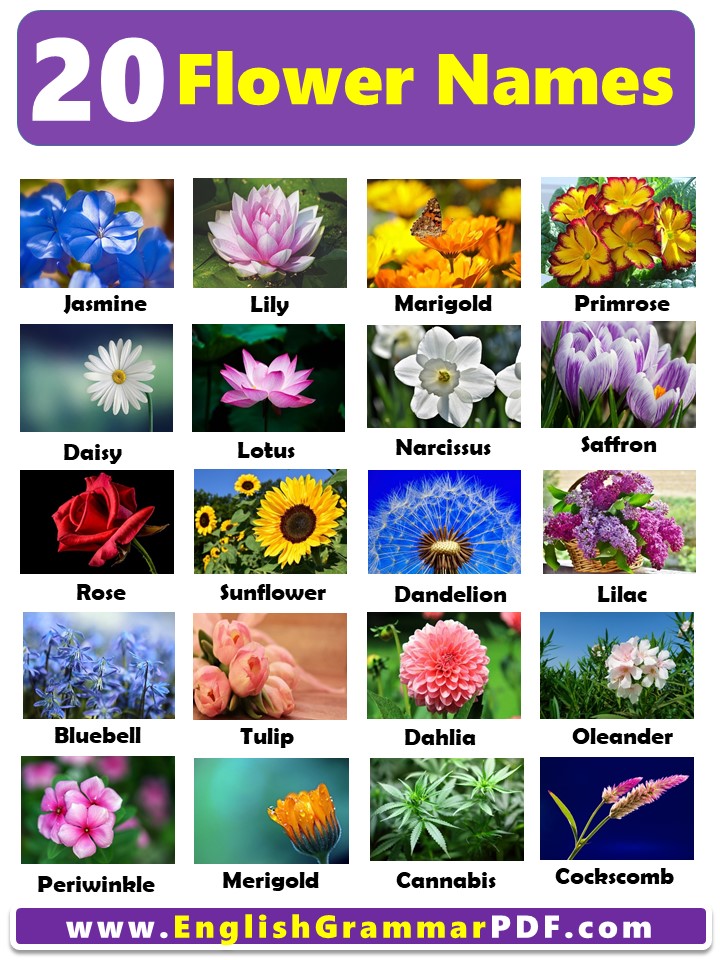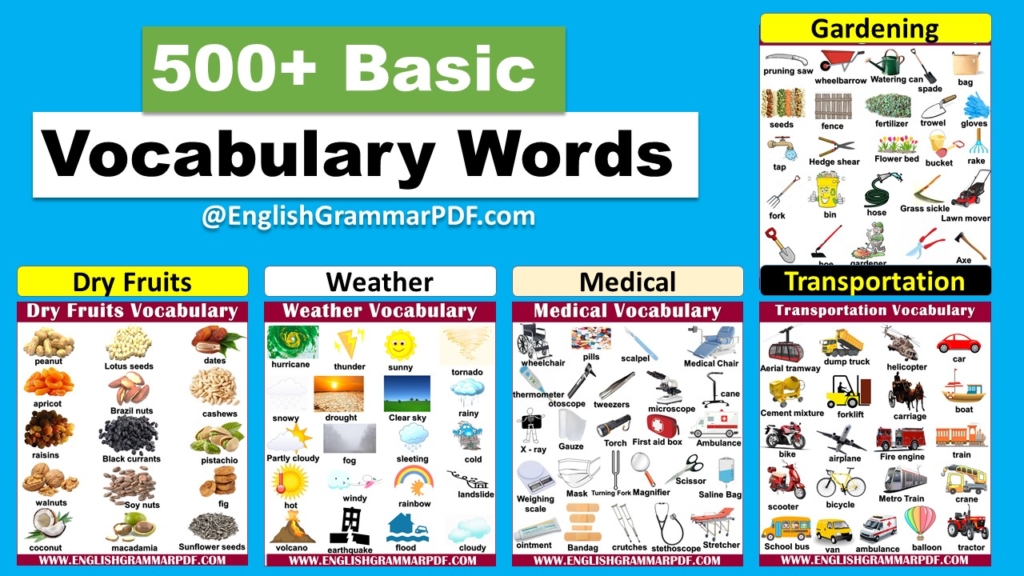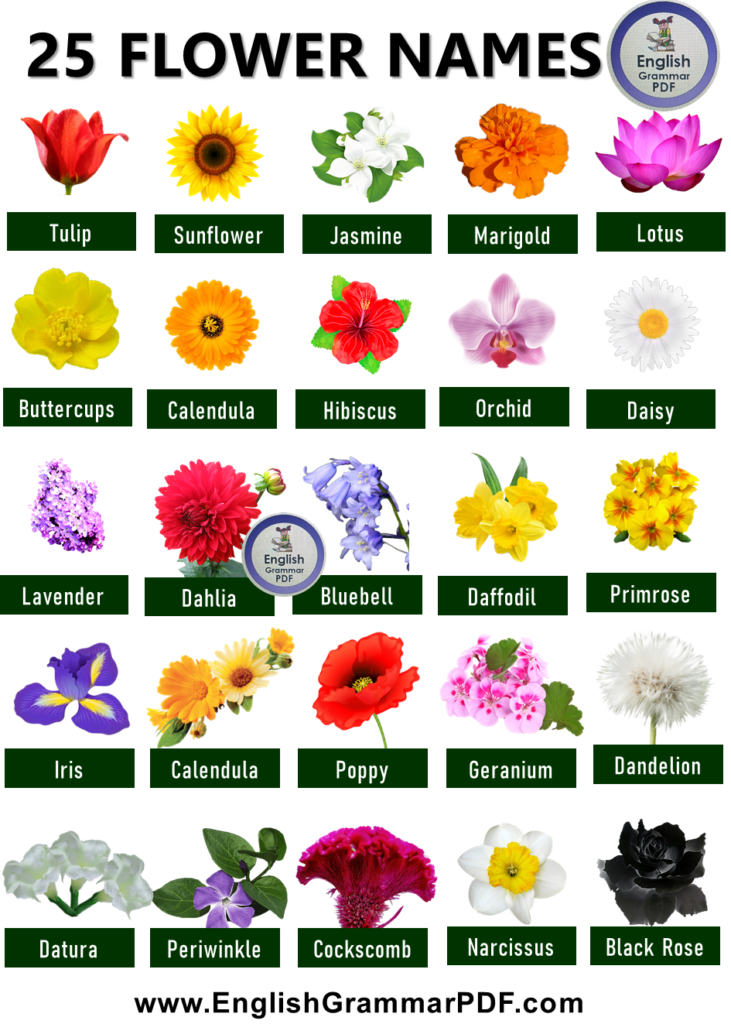Have you ever seen a garden full of colorful flowers and wished you could name them all? Today, we’re going on a fun journey to learn about 20 different flowers and how they can help you with English! Whether you’re just starting to learn English or want to get better, flowers are a great place to start.
We’ve also made a cool infographic that makes it super easy and fun to remember these flower names.
List of Flowers Name
- Jasmine
- Lily
- Marigold
- Primrose
- Saffron
- Daisy
- Lotus
- Narcissus
- Rose
- Sunflower
- Dandelion
- Lilac
- Bluebell
- Tulip
- Dahlia
- Oleander
- Periwinkle
- Cockscomb
- Calendula
- Cannabis
Flowers Names and Interesting Facts
Read one interesting fact about each flower to help you remember its name.
- Jasmine: Jasmine flowers are famous for their sweet scent, especially at night. This fragrance is often used in teas and perfumes.
- Lily: Lilies are symbols of purity and are often found in religious art. Interestingly, each color of lily has a different meaning.
- Marigold: Marigolds are known to bloom all year round. They are often used in festivals and religious events as a symbol of the sun and its power.
- Primrose: Primrose is one of the first flowers to bloom in spring. Their name means “first rose,” signaling the start of new beginnings.
- Saffron: The spice saffron comes from the saffron crocus flower. It’s the world’s most expensive spice by weight because harvesting it is very labor-intensive.
- Daisy: Daisies can tell the temperature! When it’s sunny, they open up, and when it’s cold, they close. This is why they are sometimes called “day’s eye.”
- Lotus: The lotus flower is unique because it blooms in muddy water, yet remains untouched by the mud. This makes it a symbol of purity and enlightenment in many cultures.
- Narcissus: The name narcissus is linked to the Greek word for narcotic. It’s said that smelling these flowers can cause dizziness and even fainting.
- Rose: There are over 300 species of roses. They can live for a very long time; the oldest living rose is believed to be 1,000 years old and grows on the wall of a cathedral in Germany.
- Sunflower: Sunflowers are known for “following” the sun. They turn their heads to face the sun throughout the day, which is known as heliotropism.
- Dandelion: Every part of the dandelion is edible, and it’s rich in vitamins. They are also known to bloom anywhere, which is why some people see them as a symbol of resilience.
- Lilac: Lilacs are known for their strong fragrance and are often associated with the first emotions of love. They also bloom for only a very short time each year.
- Bluebell: Bluebells are often associated with fairy tales because they create enchanting carpets of blue in the woods. It’s said that a field of bluebells is intricately woven with fairy enchantments.
- Tulip: Tulips were once more valuable than gold in Holland during the 17th century, leading to a period known as “Tulip Mania.”
- Dahlia: Dahlias are known for their varied and vibrant colors. They have no scent, which is why they can bloom so brightly; they don’t need to attract pollinators with fragrance.
- Oleander: Oleander is beautiful but deadly. Every part of the oleander plant is poisonous if ingested, making it one of the most toxic garden plants.
- Periwinkle: Periwinkle is not just pretty; it’s also powerful. It has been used in traditional medicine for its potential to treat a variety of ailments due to its natural compounds.
- Cockscomb: The Cockscomb flower, with its unusual velvety crest, resembles a rooster’s comb. It’s also known for its vibrant colors and unique shape.
- Calendula: Calendula is renowned for its healing properties. It’s often used in creams and ointments to soothe skin irritations and heal cuts because of its anti-inflammatory properties.
- Cannabis: Apart from its well-known uses, the cannabis plant produces small, fragrant flowers. These flowers are the source of various compounds that have medicinal, recreational, and industrial uses.

You can Download Pdf of this lesson.


